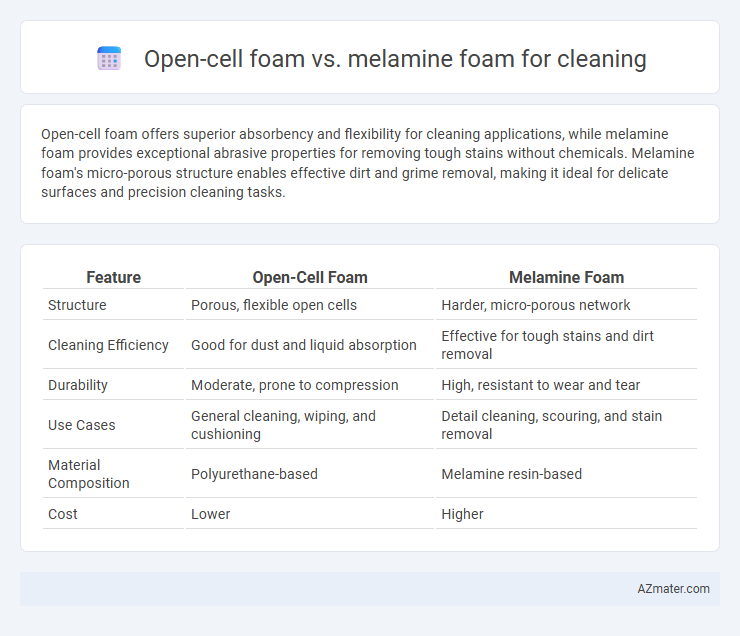Open-cell foam offers superior absorbency and flexibility for cleaning applications, while melamine foam provides exceptional abrasive properties for removing tough stains without chemicals. Melamine foam's micro-porous structure enables effective dirt and grime removal, making it ideal for delicate surfaces and precision cleaning tasks.
Table of Comparison
| Feature | Open-Cell Foam | Melamine Foam |
|---|---|---|
| Structure | Porous, flexible open cells | Harder, micro-porous network |
| Cleaning Efficiency | Good for dust and liquid absorption | Effective for tough stains and dirt removal |
| Durability | Moderate, prone to compression | High, resistant to wear and tear |
| Use Cases | General cleaning, wiping, and cushioning | Detail cleaning, scouring, and stain removal |
| Material Composition | Polyurethane-based | Melamine resin-based |
| Cost | Lower | Higher |
Introduction: Comparing Open-cell Foam and Melamine Foam
Open-cell foam consists of interconnected pores that allow air and liquids to pass through, making it highly absorbent and suitable for general cleaning tasks involving dirt and spills. Melamine foam features a unique microscopic structure that acts like a super-fine abrasive, effectively removing stains and grime without harsh chemicals. Choosing between open-cell and melamine foam depends on the specific cleaning needs, with open-cell foam excelling in absorption and melamine foam offering superior scrubbing power.
What is Open-cell Foam?
Open-cell foam is a porous material composed of interconnected air pockets that allow liquids and dirt to penetrate its structure, making it highly effective for cleaning applications. Unlike melamine foam, which is a dense, micro-structured material designed for abrasive cleaning, open-cell foam offers excellent absorbency and gentler scrubbing due to its soft, flexible texture. This makes open-cell foam ideal for cleaning delicate surfaces where debris removal requires trapping particles without causing surface damage.
What is Melamine Foam?
Melamine foam is a highly porous, lightweight material made from a thermosetting resin, known for its excellent cleaning properties and micro-abrasive texture that can remove stains without harsh chemicals. Compared to open-cell foam, melamine foam offers superior dirt-trapping capability due to its microstructure, making it ideal for delicate surfaces and detailed cleaning tasks. Its unique composition allows it to act like a very fine sandpaper at the microscopic level, effectively lifting grime and discoloration from various surfaces.
Key Differences in Material Composition
Open-cell foam features a porous structure made of polyurethane, offering flexibility and excellent absorption properties ideal for soaking up liquids and trapping dirt. Melamine foam is a rigid, thermoset polymer with a micro-porous network, providing superior abrasive qualities that effectively remove stains and grime without scratching surfaces. The key difference lies in polyurethane's soft, sponge-like texture versus melamine's hard, fine-structured form, influencing their suitability for different cleaning tasks.
Cleaning Efficiency: Open-cell vs Melamine Foam
Open-cell foam excels in cleaning efficiency by trapping larger debris and absorbing liquids through its porous structure, making it ideal for general surface cleaning. Melamine foam offers superior cleaning power on tough stains and grime due to its micro-abrasive texture that breaks down dirt without harsh chemicals. Comparing open-cell and melamine foam highlights melamine's advantage in deep cleaning and stain removal, while open-cell foam suits tasks involving liquid absorption and particulate capture.
Durability and Longevity
Open-cell foam offers high absorbency and flexibility but tends to deteriorate faster under heavy cleaning use due to its porous structure, resulting in reduced durability. Melamine foam, composed of a rigid microstructure, provides superior longevity and maintains cleaning effectiveness even after repeated use, making it highly durable for tough cleaning tasks. Choosing melamine foam ensures extended service life, especially for abrasive or intensive cleaning applications.
Safety and Chemical Resistance
Open-cell foam offers excellent chemical resistance and is generally safe for use with a range of cleaning agents, making it ideal for absorbing and scrubbing without releasing harmful particles. Melamine foam, famed for its microstructure, provides superior surface abrasion with minimal chemical resistance, which limits its use to water-based cleaners and requires careful handling to avoid skin irritation. Prioritizing safety, open-cell foam is preferred in industrial cleaning contexts due to its non-toxic nature and durability against harsh chemicals.
Cost-effectiveness for Cleaning Applications
Open-cell foam offers cost-effective cleaning solutions due to its durability and ability to trap larger debris, making it suitable for heavy-duty applications. Melamine foam, while typically more expensive per unit, provides superior cleaning precision by effectively removing stains and dirt through micro-abrasion. Choosing between the two depends on balancing initial expense against long-term cleaning efficiency and specific application needs.
Ideal Use Cases for Each Foam Type
Open-cell foam excels in cleaning applications requiring deep absorption and cushioning, making it ideal for delicate surfaces and irregularly shaped objects prone to scratches. Melamine foam, known for its micro-porous structure and abrasive properties, is perfect for removing tough stains, scuffs, and dirt from hard surfaces like walls, tiles, and countertops without the need for harsh chemicals. Choosing between open-cell foam and melamine foam depends on the cleaning surface type and the level of abrasive action needed for effective stain removal.
Conclusion: Choosing the Best Foam for Cleaning
Open-cell foam offers excellent absorption and cushioning properties, making it ideal for heavy-duty cleaning tasks involving liquids and debris. Melamine foam, with its microstructure acting as a fine abrasive, excels in removing tough stains and grime from delicate surfaces without scratching. Selecting the best foam depends on the cleaning application: opt for open-cell foam for liquid absorption and general cleaning, while melamine foam is superior for precision stain removal and surface restoration.

Infographic: Open-cell foam vs Melamine foam for Cleaning
 azmater.com
azmater.com